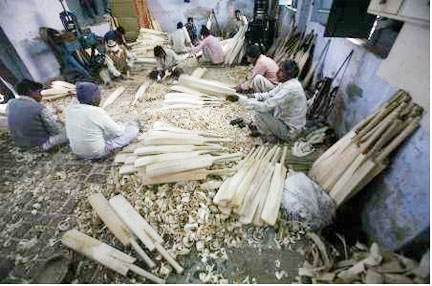MEERUT, India, (Reuters) – When the world’s batsmen dazzle crowds at this month’s cricket World Cup, many will use bats hand-made in India. But lucrative global branding that masks the bats’ true makers threatens the country’s craftsmen.
In cricket-mad India, family businesses that have supplied the country’s leading cricketers for generations face an uncertain future of anonymity as global giants swamp the game with cash in exchange for TV-friendly logos on the big-hitters’ bats.
“Buying players with advertising is far cheaper than investing in making bats. We are crafting bats, they are using stickers. They are ruining our brands, because we cannot afford to give that kind of money, those royalties to the players,” says Rakesh Mahajan, director of B.D. Mahajan and Sons (BDM).
In his dust-filled workshop in the northern Indian city of Meerut, dozens of workers cut, glue, sand and bend hundreds of bats everyday to the exact specifications of international superstars, who rely on their decades-old techniques.
“Sponsorship is no harm, but removing the manufacturer’s branding is not fair. We are building the bats, but people are not recognising us: the sponsors are taking the credit,” says Mahajan. In his wood-paneled office, over the sounds of sawing and banging below, Mahajan proudly shows photos of players using BDM bats. But the pictures are undeniably dated: Former superstars carry the logo, but the current crop have followed the money. “We have no issue with Gray Nicholls, or Kookaburra,” says Mahajan, referring to the long-established UK and Australia-based equipment manufacturers.
“The problem is Nike, Reebok, Adidas, people like Brittania and Hero Honda. They make biscuits and motorbikes, not bats!”
BDM employs 300 people in its two factories in Meerut, 80 kilometres north-east of Delhi, where hundreds of sports companies gather at a major hub in the country’s estimated 10 billion rupee ($219 million) cricket equipment market.
Wood shavings carpet the stone floor of the bat workshop, where scores of workers squat, filing the edges of countless bats to a smooth finish under towers of willow planks and cane handles that climb to the ceiling.
Boxes of finished bats pile up in every direction from the factory entrance, ready to be distributed across India and the world to global superstars, academy players and amateur batsmen.
WORLD CUP BOOM
Despite Mahajan’s fear of cricket’s commercialisation, which exploded with the launch of the billion-dollar Indian Premier League in 2008 that sent player wages and TV rights skyrocketing, he admits the globally-viewed World Cup is good for business.
Demand is strong, and Mahajan’s sparkling 4×4 on the dusty lane that runs through the industrial estate filled with sports manufacturers attests to BDM’s 10-15 percent annual growth.
With the first match just weeks away, the factory is churning out 1,200 bats a day for its largest ever order, and to meet soaring demands from schools and local authorities, while sacks are stuffed full of cricket balls branded with carmaker logos for promotional release during the tournament, which begins Feb 19.





